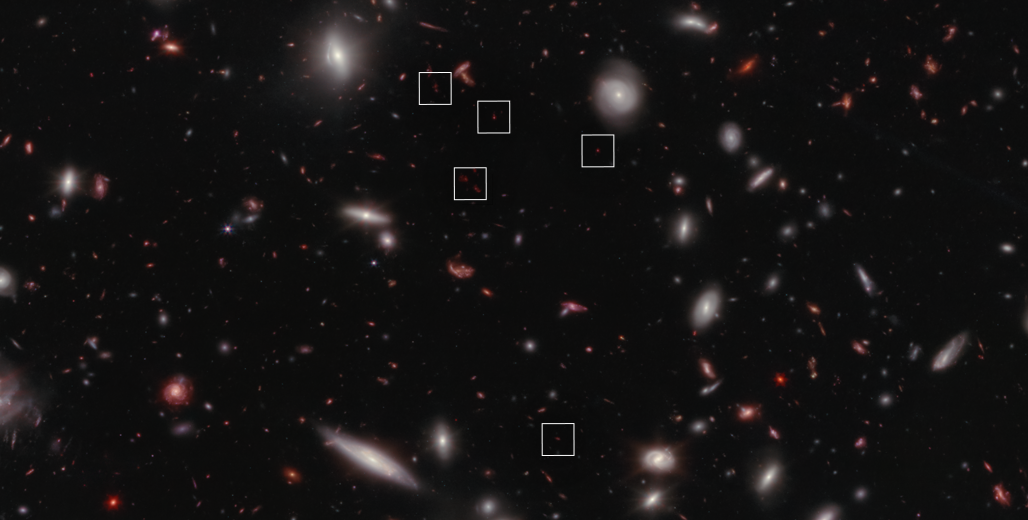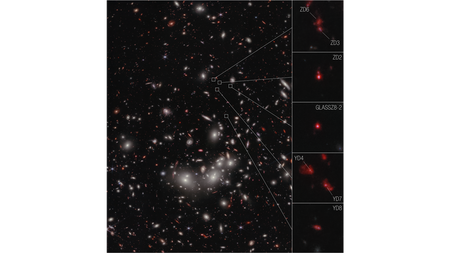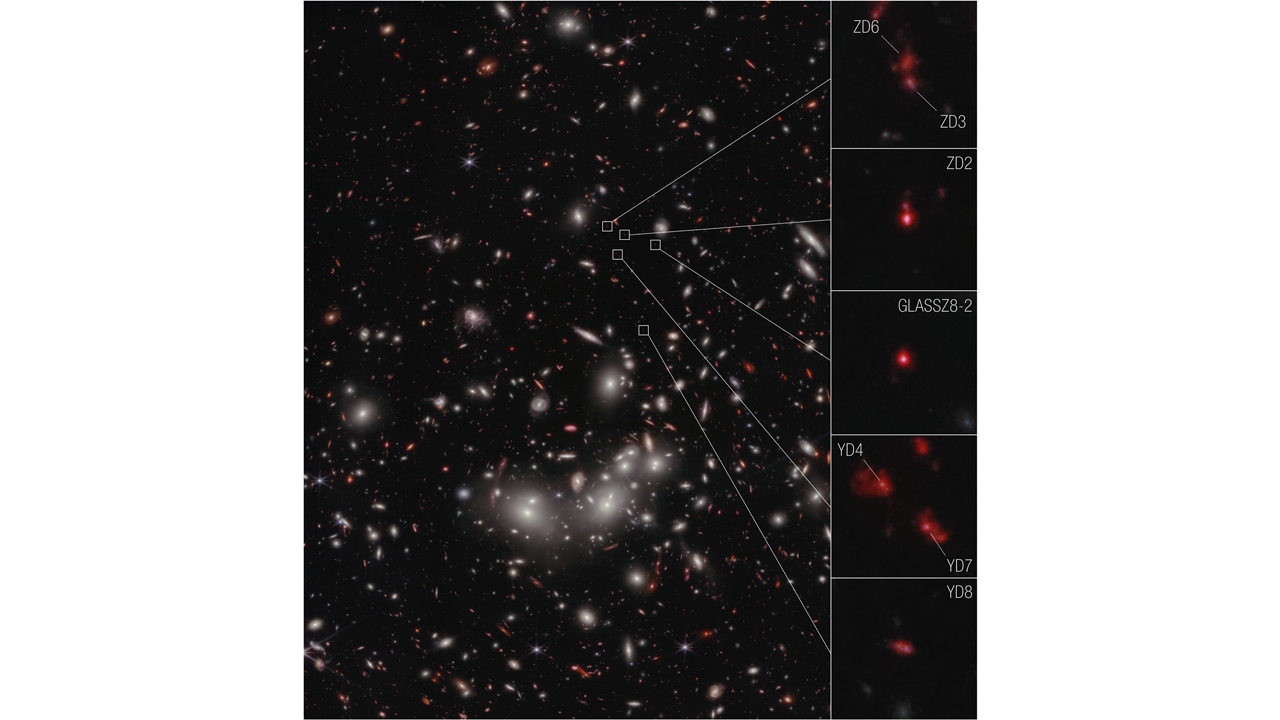
The Young Cluster of Galaxies at the Edge of the Universe
Astronomers have looked back in time to the early beginnings of the universe, a mere 650 million years after the Big Bang, and observed the baby stages of seven interacting galaxies forming into a protocluster. This protocluster is currently the most distant cluster of galaxies to be confirmed by scientists. Simulations show the system will have now evolved into one of the largest and oldest known galaxy clusters in the universe, over 100 times more massive than our Milky Way galaxy.
A paper describing the findings appears in the journal The Astrophysical Journal Letters on April 24. The lead author is Takahiro Morishita, a staff scientist at Caltech's IPAC astronomy center.
The seven galaxies were first spotted with NASA's Hubble Space Telescope. However, though all of the galaxies were observed along the same line of sight, Hubble was not sensitive enough to determine exactly how far away the galaxies were from one another. As an analogy, imagine flying far above Los Angeles and looking out the window with a telescope—you might see cities like Phoenix, Dallas, and Atlanta, but you would not know the exact distances between them.
Using NASA's James Webb Space Telescope (JWST), the team was able to precisely measure the distance from Earth to each of the seven galaxies by measuring a property called redshift. Redshift is a measure of how far away galaxies are from Earth—the farther the galaxy, the higher its redshift. Due to the expansion of our universe, light from galaxies will shift to longer, "redder" wavelengths with distance in the same way that sound waves from a passing ambulance's siren shift to longer, lower frequencies as an ambulance drives away from you. To learn a galaxy's redshift, astronomers capture its spectra—a rainbow of wavelengths emitted by the galaxy—and look for known signatures of molecules like hydrogen and helium. Those wavelengths will shift, or become redshifted, with increasing distances.
Surprisingly, each of the galaxies has the exact same redshift—7.88, which translates to 13 billion light-years from Earth (for reference, a single light-year, the distance that light travels in one year, is 9.4 trillion kilometers)—indicating that they are all clustered together. The system, located in the constellation Sculptor, is currently the farthest spectroscopically confirmed protocluster to date.
"We knew for a while from the Hubble data that there was an interesting over-density of galaxies. It came as a surprise when we first saw the spectra from JWST—all seven galaxies were aligned at the exact same redshift," Morishita says.
Because the light from these galaxies has taken billions of years to reach the telescopes, astronomers are seeing them as they existed long ago, only hundreds of millions of years after our universe was born. Given their size at that time, they could be some of the very first galaxies ever formed. Though we cannot see the cluster as it exists today, numerical simulations predict that it may now be one of the most enormous clusters in the universe.
The scientists say that clusters of this nature are very rare and hard to spot. "It's not likely that we'll find another special system like this using JWST," Morishita says. "Given that JWST sees relatively small areas of the sky, we need a telescope that can see the bigger picture."
In the next decade, discoveries like these will be further enabled by the Nancy Grace Roman Space Telescope, NASA's forthcoming observatory expected to be launched by early 2027. Its wide-area survey capability will be more than 100 times that of JWST and will facilitate the identification of galaxy clusters in the early universe like the one discovered in this study.
The findings are some of the first to come out of JWST's initial science run. "These findings are the result of a massive international collaboration," Morishita says. "It was really a team effort to deliver this exciting news to the world so quickly."
The paper is titled "Early results from GLASS-JWST. XIV: A spectroscopically confirmed protocluster 650 million years after the Big Bang." A full list of collaborators can be found here. Funding was provided by NASA, the Australian Research Council, the Villum Foundation, the Danish National Research Foundation, the Australian Research Council Center of Excellence, Italy's National Institute for Astrophysics; the Slovenian Research Agency, the Dutch Science Organization, the Christopher R. Redlich Fund, the Australian Government Research Training Program, the Jean E Laby Foundation, and the Center for Advanced Study at The Norwegian Academy of Science and Letters.
IPAC is partnering with NASA's Goddard Space Flight Center and the Space Telescope Science Institute to provide the science center functions for the Roman Space Telescope. The Jet Propulsion Laboratory, managed by Caltech for NASA, is building the Roman Space Telescope's coronagraph Instrument, which will perform high-contrast imaging and spectroscopy of dozens of individual nearby exoplanets. IPAC is responsible for operating the coronagraph instrument and community engagement for exoplanet science.
 The seven galaxies highlighted in this James Webb Space Telescope image have been confirmed to be at a distance that astronomers refer to as redshift 7.9, which correlates to 650 million years after the big bang. This makes them the earliest galaxies yet to be spectroscopically confirmed as part of a developing cluster.
Credit: IMAGE: NASA, ESA, CSA, Takahiro Morishita (IPAC). IMAGE PROCESSING: Alyssa Pagan (STScI)
The seven galaxies highlighted in this James Webb Space Telescope image have been confirmed to be at a distance that astronomers refer to as redshift 7.9, which correlates to 650 million years after the big bang. This makes them the earliest galaxies yet to be spectroscopically confirmed as part of a developing cluster.
Credit: IMAGE: NASA, ESA, CSA, Takahiro Morishita (IPAC). IMAGE PROCESSING: Alyssa Pagan (STScI)

